Scarlet Elf Cup – Identification, Edibility, Distribution, Ecology, Recipes
Sarcoscypha austriaca
also Sarcocypha coccinea, the Ruby Elf Cup
Both these species are variously referred to as scarlet or crimson elf cups. They are virtually indistinguishable to the naked eye. Learn more about their microscopic differences on the Scottish Fungi website here.
- Edibility – 3/5 – Some guide books list them as inedible, perhaps because of their lack of succulence. I have heard one “uncorroborated report from someone who read somewhere that they may not be especially good for you in large quantities” (like a lot things!), but have been unable to track down the reference. I rate them highly and eat a small amount every year, and am yet to encounter anyone who has had any issues eating them. As with all wild fungi, eat only a small amount, cooked, the first time you try them.
- Identification – 5/5 – Crimson red, young specimens goblet shaped, stem becoming less noticeable with age so becoming cup-shaped, 1-5cm diameter, pale on the outside, thin fleshed. Orange variants (not to be confused with orange peel fungus, which does not grow at the same time of year) occur occasionally, as do even rarer pure white variants.
- Distribution – 3/5 – Can be found in large numbers where established. They seem more common in the West and near the sea. I suspect this is to do with heavier rainfall and exposure to prevailing winds, which tends to create more windfall.
- Season – December to April – often flushing after a thaw
- Habitat – Fairly common in humus rich, damp, deciduous woods with plenty of fallen wood, from which they grow. They have a preference for moss-covered sycamore, willows, beech and hazel, though identification of host trees can be tricky as they are usually in an advanced state of decay and covered in moss. I find most of mine in snowdrop and wild garlic-filled woods.
- Ecology – Scarlet elf cups are saprophytic (rotters) on fallen deciduous wood – a secondary decomposer. A 2011 research paper indicates that elf cups play an important role in releasing nutrients from woody debris in early spring, supporting the growth of early spring plants. Unlike most edible fungi, elf cups are ascomycetes, meaning that they actively shoot their spores into the air, rather than dropping them through pores or gills like basidiomycetes. Scarlet elf cups offer one of the best opportunities to observe this phenomena: by blowing on them (ideally later on in their growth cycle) can trigger them to shoot clouds of spores which can be seen with the naked eye. This is not the movement of your breath raising a cloud, but the subtle change in temperature that it brings triggering many thousands of spores into being simultaneously shot from the inner surface of the cup by pneumatic action. Try it, its amazing – great fun to do with kids, and a reminder that we can actively support spore dispersal. You can view a short video of it happening here.
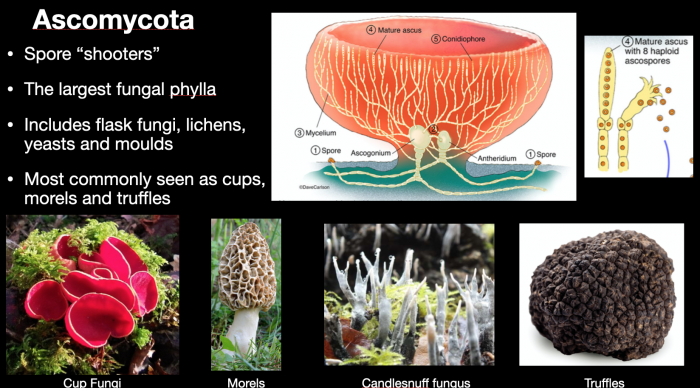
Ascomycota – spore shooters, slide from my Fungi Identification Webinar
Foraging is full of pleasant surprises, and elf cups are one of its best. I find lots in a snowdrop and ramson-filled wood by the sea and the contrast of the red elf cups, white flowers and vibrant green moss makes it a very special place in February.
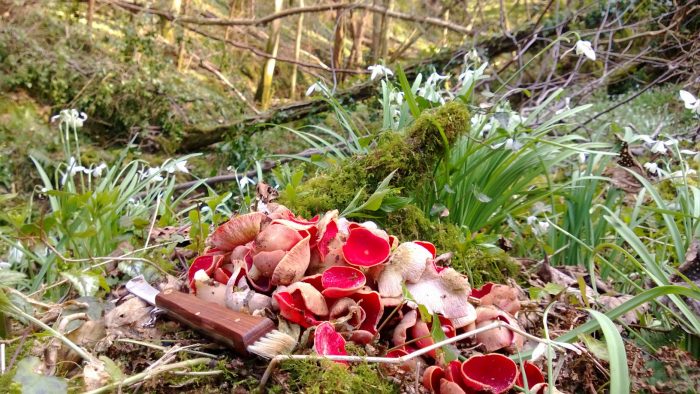
When you see snowdrops, scarlet elf cups are often nearby
I admired them for years without really bothering to try eating them – their thin red flesh put me in mind of chamois leather and didn’t seem to offer too much promise of flavour, and most fungi guides either omitted them or were circumspect about their digestibility. So when a keen wild food chef I work with started raving about them, I decided it was time to do some research, give them a go, and share my thoughts here. That was nearly 10 years ago, and since then scarlet elf cups have rocketed from near obscurity to winter social media superstars of the wild food world. Its hard to find a foraging social media feed that isn’t plastered with them in February – not surprising given their startling beauty!
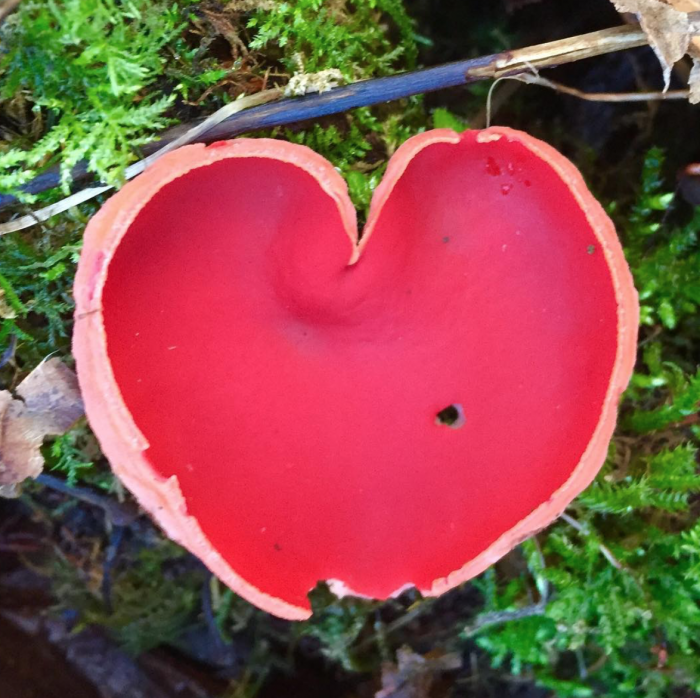
Scarlet elf cups are often at their peak around Valentines day…
Scarlet elf cups have a subtle, earthy flavour – fungal, with perhaps a hint of beetroot. Though the texture isn’t typical of mushrooms, they do cook well – either frying or in stews seems best. Once you park your expectations of what you think a mushroom should taste and feel like in your mouth, and embrace them for what they are, most people find them tasty.
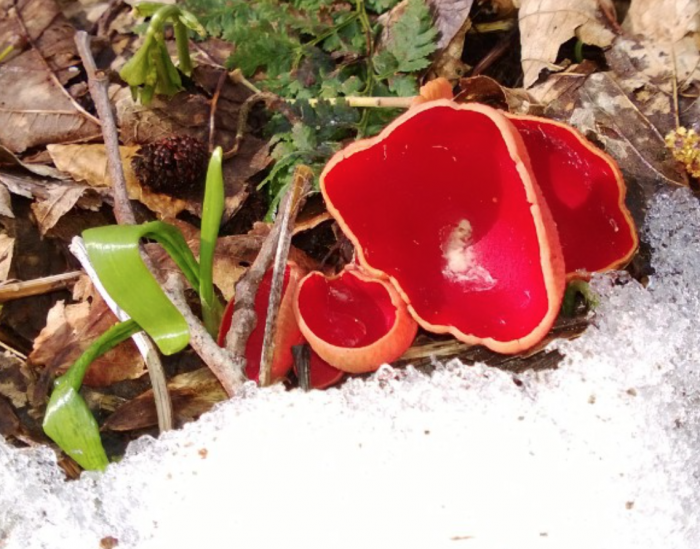
Elf cups can survive freezing and often can be found as snow melts. Here with early wild garlic shoots – a common bedfellow.
They lend themselves so well to holding things, that I can’t resist filling them with other woodland gifts for some on-the-hoof raw hedgerow munching. I don’t usually recommend eating wild fungi raw, but haven’t encountered any problems with elf cups. If you do give it a go, try a little bit the first time. Early few-flowered garlic shoots, baby velvet shank (which taste like mushroom toffee!), pink purslane and cep-infused lichen have all worked well and look, frankly, stunning.
Watch a video of me making wild winter elf cups sushi/hedgerow canapé/amuse bush…
Scarlet elf cups are related to the equally attractive orange peel fungus which appears in the autumn usually on disturbed ground, new path edges etc. They look exactly as their name suggests, and I regularly pounce on actual orange peel by mistake!
Elf cups can be found in large numbers in certain places when they are flushing, but even then I urge people to pick these beautiful fungi with restraint and leave plenty to continue to do their important work decomposing wood and for others to enjoy. Read more about responsible mushroom picking here.
Below are some ideas and recipe suggestions on what to do with elf cups.
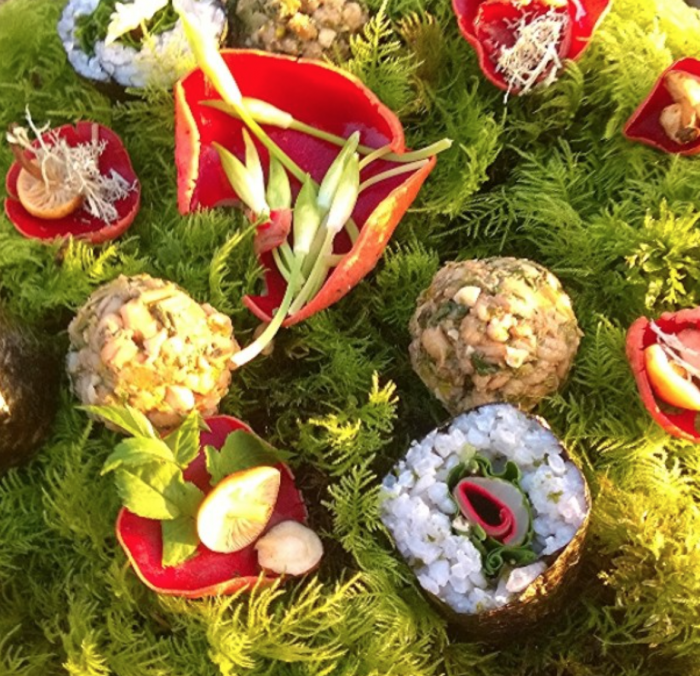
‘Elf Food
View this post on Instagram
View this post on Instagram
View this post on Instagram
View this post on Instagram
View this post on Instagram
View this post on Instagram
View this post on Instagram
View this post on Instagram
View this post on Instagram
View this post on Instagram
View this post on Instagram
Related Pages:
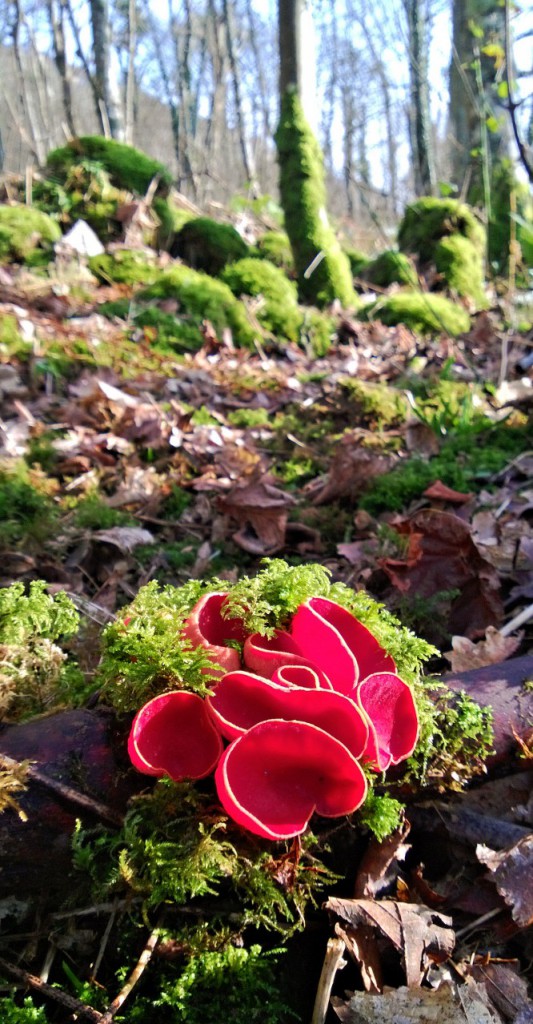

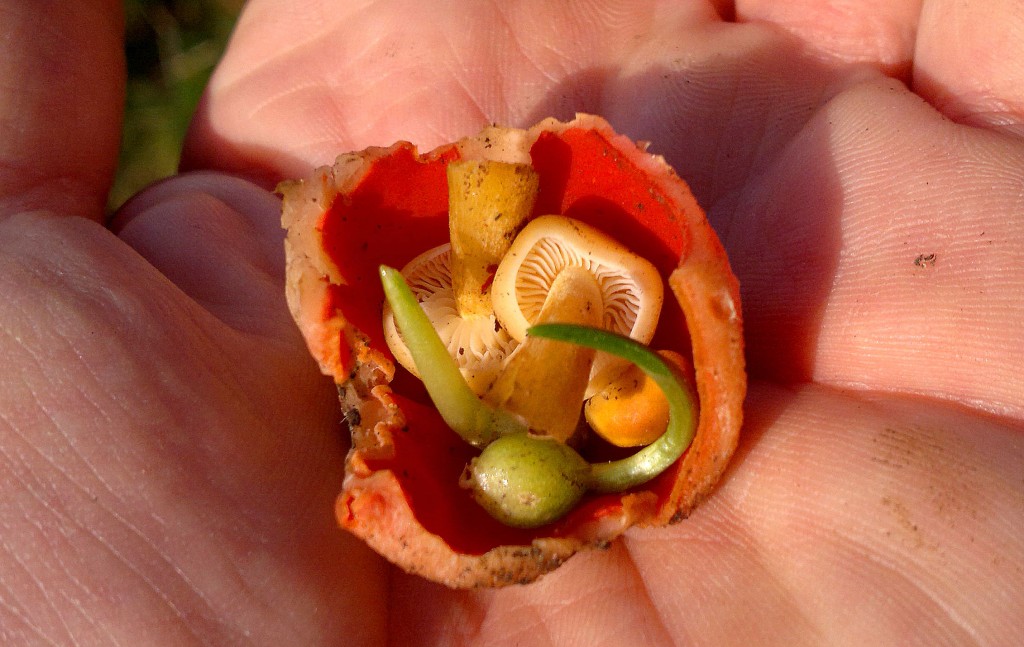
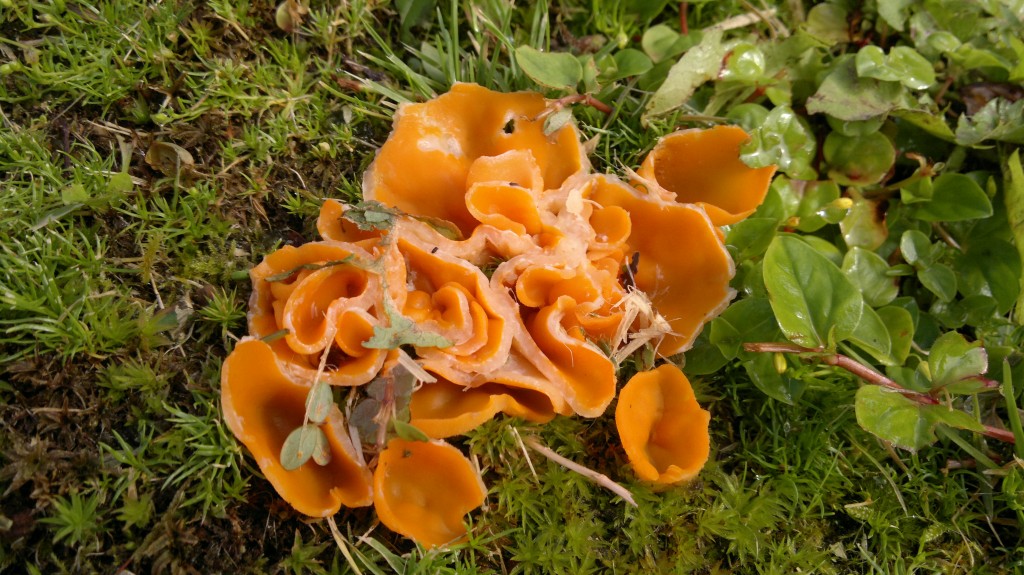
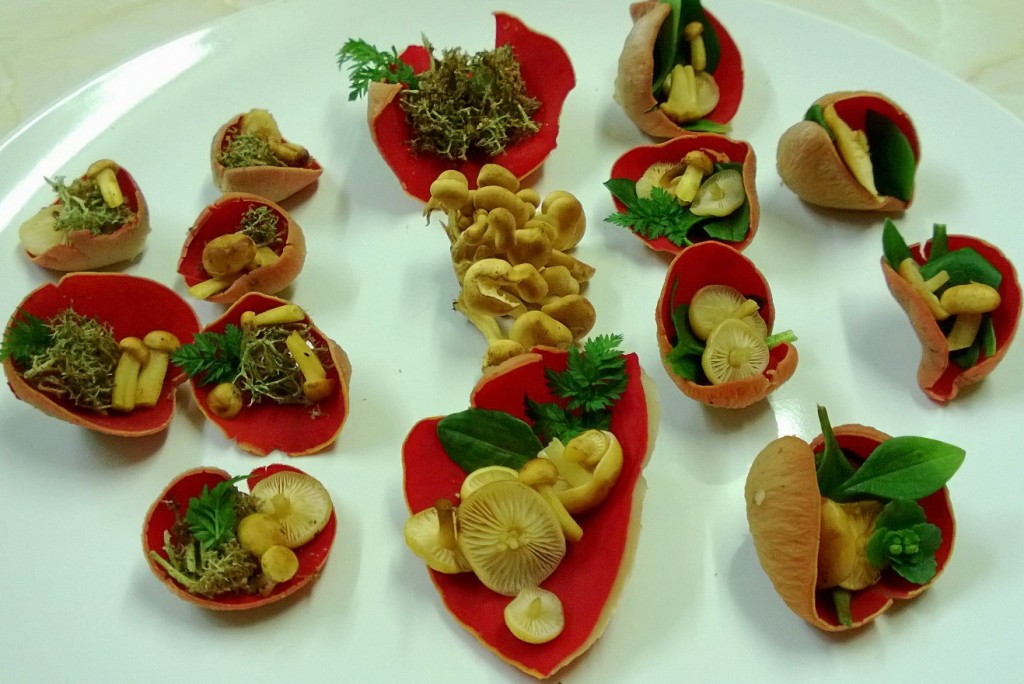
47 Comments
Those elf cup sushi ought to be on the menu at Noma! Brilliant. I must have a look through your articles and see if there’s anything else the mushroom books label “inedible” that are actually worth trying.
Thanks Matthew. Have a look at the clouded agaric entry – they aren’t usually recommended but I have no problems with them. Lots more to come, bu never enough time!
did you have any side effects eating one of them
No, never. Nor have I heard of anyone having a side effect. Unlike ceps and chanterelles!
20/05/2015 identified at Brandon Marsh Warwickshire scarlet elf cup fungi brilliant!!!
identified at brandon marsh warwickshire scarlet elf cup fungi brilliant1
Thank you for this article!!! I found some of these a few days ago but couldn’t find them in my edible wild mushrooms book so I assumed they were poisonous! I’m gonna head back out to the woods in a few and get some now thanks to your article!
They ARE too pretty to pick and you’re ignoring the issues of other life forms that depend on the fungi you are destroying, and the beautiful sight that you are denying to other people who might want to view these. Basically it’s selfish and unnecessary. Please stop it. There’s little enough nature left as it is.
Hi Jenny,
I certainly don’t ignore issues around the complexity of nature. I’m more aware than most self-proclaimed “nature-lovers” of the fact that, until we learn to interact with nature in meaningful ways, rather than ring fencing it, it will always be at risk.
Whenever I am challenged on this sort of thing, I ask the person asking to serious look at their own diet and its hidden consequences… monocultures, food miles, cataclysm-based farming practices… ALL (and I mean ALL) food has consequences elsewhere in the food chain. Some people like to pretend they are not a part of nature, and shield themselves from the wider impact of their diet.
If you can let me know of any of “the issues of other life form that depend on the fungi” you claim I am “destroying”, then please share and I will alter my information. Please stick to science-based evidence if possible. I would draw your attention to the several scientific studies in the following link that shows no relationship between harvesting edible mushrooms and the health of the mycelium from which they grow.
Recommended reading:
What you are suggesting is rather like asking me to stop picking crab apples from my local hedgerow, because you like looking at them and have some vague (but unspecified) notion, that other things might eat them.
Mark
Hi Jenny
I’d like to say that I appreciate your concern deeply, There are not many People who actually care at all for nature,, and Science isn’t right about everything. At the end of the day this beautiful fungus has a role to play as both you and mark know. As mark says picking the fruiting bodies does not harm the mycelium growing in the wood,,, a little picking is good and encourages and spreads the spores further but over picking is not good because the fungus need to spore plenty. Also the spores are food for other microorganisms. But it’s also important as Mark said to get people connecting with nature. It would certainly sow seeds in people’s hearts to later respect it. But I believe in emphasising the need for respect and moderation.
Thank you Jenny for bringing some common sense to this ‘frenzy’ (for that is what it is) of eating something wild just because it is ‘pretty’.
At the beginning of this article I was horrified to read the author (Mark) enthusiastically recommending that this beautiful fungus should be eaten despite him knowing somewhere that it is written there are doubts about its edibility – just because one person survived with no apparent ill effects doesn’t mean to say the next person will (quote that great film, The Life of Brian … “You are all different” !)
And next in the article we see a huge frying pan full of these elf cups followed by a short sentence about picking these with restraint – yes Mark.
Sure enough, this comments section now comprises mostly of comments from people who now plan to go out into the woods to ”try” these out … … and we can all guess how they will go about this task.
Yes, they will take a Tesco’s plastic carrier bag and fill it to the rim (or try to) with all they can find with anything they think ‘looks edible’ … and when they hit upon Scarlet Elf Cups, they will take the lot.
Scarlet Elf Cups may be more plentiful in other parts of the UK, but here in East Anglia they are in very limited supply.
Fungi contain a lot of water, so it goes without saying that other wildlife must eat fungi as part of their natural diet, and yes, the fungal mycelium will still be in the substrate continuing to do its vital work in re-cycling the dead wood upon which it is growing or rather, absorbing, and hopefully will produce more spectacular fruiting bodies next year.
I use the word ”hopefully” for the very reason I am the person who re-discovered the extremely rare Candelabra Coral Fungus – this had not been seen in the UK for over 100 years and was thought to be extinct.
At the time, I was leading a private fungus foray and I came across a clump of this coral fungus and was immediately struck by its similarity to a real multi branched Candelabra and straight away assumed this is what this species must be called (but not knowing how very rare it was at the time)
I knew it was ‘special’ so removed a small frond to examine back home under the microscope and at the same time urged people present not to pick it because it may turn out to be very special.
Back home, I discovered the sporeprint was white and got out all my reference books but because it was thought to be extinct in the UK I could find very little information – luckily, one of the countries finest field mycologists was leading a fungus course at Flatford Mill Field Studies Centre, so the following day I took my sample down to show him.
“Candelabra Fungus” he immediately exclaimed, and within the minute he was on his phone to Kew to say “Candelabra Fungus … its been found” ! This sample is now preserved in the National Fungorium at Kew.
In the meantime, I had to return to the site to take photographs, get a 10 figure grid reference, and get the land owner to protect the log pile upon which it was growing … all very well except IT HAD DISAPPEARED !
Me and the landowner spent many hours trying to re-locate this fungus but it was nowhere to be seen but almost certainly one of the members of the foray I was leading must have stayed behind and thinking the fungus was edible or looked so pretty, selfishly took all that was left – and despite my searching the wood intensely for the last 3 years, it has never appeared again.
Please Mark … think carefully about what I have written and try to stick to the genuinely common fungi such as Velvet Shank and Oyster Fungi and leave others well alone.
Thank you for your time,
Neil.
Hi Neil,
You appear to have selectively read what I have shared about this fungi both in the post and in the comments thread. I recommend you re-read the above and have a look at the following posts too if you want to contribute meaningfully:
The Spectrum of Edibility
Foraging, Sustainability and the Media
I’m not sure how you manage to equate 3 people over 4 years mentioning they will try eating this fungi to a “frenzy”? You appear to have ignored the comments by people who have learned about this beautiful fungi and expressed new admiration for fungi, with no mention of any interest in eating them.
The information I have shared here is honest, clear and responsible, and allows people to make their own judgement about what they eat. If you have any scientific information that you can add to a constructive discussion, i’d love to read it, and will amend what I have written if new information becomes available. Even anecdotal information is helpfulThe only useful contribution is your observation that they are less common in East Anglia – thanks for that.
Apart from the factual inaccuracy of this comment, it also demonstrates a very low opinion of your fellow nature lovers, who perhaps appreciate fungi in a slightly different way to you. Of course a few people do gather thoughtlessly (including a long history of botanical and mycological “collectors” with no interest in eating), but in my experience these are a tiny minority. The many hundreds of people I teach every year arrive with a love of nature and leave with a clearer understanding of how they relate to it, how to cherish and nurture it. Certainly nobody would leave one of my fungi walks so lacking in knowledge and appreciation that they would return to “loot” rare, inedible fungi!
Fortunately, your low opinion of those who wish to connect with nature more intimately through their diet (by thoughtfully eating what is abundant around them and thereby reducing their overall impact on nature) is slowly dying out. “Look but don’t touch” attitudes to Fortress Conservation, while useful in occasional instances, are doing very little to make a positive change to the relationships between humans and the natural world – in fact for the most part they serve only to further alienate mankind from nature. More and more of my work is now with conservation organisations that are recognising the importance of foraging in safeguarding nature. Only last week, in partnership with Scottish Natural Heritage, I taught 20 outdoor educators about scarlet elf cups. At times, it was hard to put a foot down without treading on one. We cooked them with wild garlic – which is also abundant in SW Scotland.
With regard to scarlet elf cups in particular:
– I have eaten this fungi on a regular basis for 8 years – no ill effects.
– Many thousands of people eat this fungi every year, with no ill effects. Its served in restaurants.
– In some areas it is hyper-abundant, in others it is scarce or not present due to lack of suitable habitat.
– Some year’s elf cups are hyper abundant near me, other years less so, but certainly no general decline in numbers.
– Habitat loss (through loss of woodland, or misguided “tidying” of fallen timber) is the main threat to their abundance – not foraging.
Oyster mushrooms are not common near me. So I’ll pass on your advice to eat more of them.
Regards,
Mark.
I’m in Cumbria/Lancashire and these are SO abundant this year. I have no guilt taking a few. They are not actually something that one would eat huge amounts of. But foraging does teach one just how difficult it is to gather enough of anything to make a days meals…..makes one much more respectful of the farmers work.
Glad you are enjoying them! I like to imagine just how much more foraging there would be (in terms of both uptake, volume and diversity) if modern farming and agribusinesses weren’t reducing our landscape to sterile strips of green monoculture, grown for silage, or uplands/forests decimated by sheep grazing. In general lamb and beef, are prestige but not practical foods, when you measure their true impact on the environment.
Hi Neil
I’m not sure where in East Anglia you live and forage….but I find scarlet elf cups to be fairly common in my area of east anglia….
I strongly agree!!! They are such an uplifting treasure to discover. Let people be in awe of them and let nature not humans manage them.
I find most of mine in and around an intensively “managed” and certainly man-made wood…so where does that leave us? That said, I take a small proportion of them at the end of their reproductive stage. Also, I find it a strange kind of cultural appropriation when people decide to remove things from other people’s diets so they can “look at them”. I wonder what they go home and eat that has less impact on the natural world (however you choose to define that)? There is a discussion of this strange phenomenon here.
Not necessary now is it now the world gone into global metal down with covid19 all about living of the land
If I could “like” Marks response to Jenny’s comment I would!
Mee too. Brilliant come back
Me too. I have one person in my hiking group has the same idea as Jenny, wonder they’re relative.
Very interesting saw these on a walk yesterday stunning vivbrant colour thanks for the info fee
I found some of these in my wood yesterday. I didn’t know they were edible. They look beautiful 🙂
Thanks so much for taking the time to post this information – I came across lots of these today on a woodland walk today in Wiltshire having never seen them before, and I was sure they must be inedible because of the beautiful scarlet colouring. Knowing they’re edible makes them even more fascinating! Thanks once again.
We have swaths of these in the woods (we’re in the west by the sea in beautiful Pembrokeshire). Like Vicky, given their colour I photographed them but instantly thought them inedible, after reading a few articles we’ll try them cooked tomorrow, and then might even attempt to freeze a few for later. Beautiful, useful site, many thanks x
My friend and I came across these beautiful items of nature today. We live in the United States…in Iowa…nowhere near the sea, so I feel our find is extra special! Thank you for this article!
Nice one! Glad it helped. Elf cups alway feel special!
My theory around them being more common around the coast is to do with more exposure = more wind = more fallen timber = more habitat, rather than any more specific maritime preference of the species itself.
Cheers,
Mark.
Tracey, I am sure you are correct and you have found what we here in the UK call Scarlet or Crimson Elf Cup, but if you are tempted to give them a nibble, please do so with extra caution because what looks to be the same in the States is not necessarily the same species we have in the UK.
Here I am thinking about that very sad story of a Mother and daughter from Viet-Nam who moved to the USA and came across what they thought was the edible Paddy Straw Mushroom (Volvariella volvacea) which is very common in South East Asia.
But in fact it was the identical and deadly poisonous Death Cap fungus (Amanita phalloides) the mother had found, and she told her daughter these are what she used to eat as a child back in Viet-Nam.
The mother picked them and I believe made them into a soup. The daughter was more wary and only had a little.
The mother died, but thankfully the daughter was saved.
Good advice Neil, though I think you need to be quite pessimistic to equate confusing V.volvacea & A.phalloides with mixing up elf cups with anything unpleasant…
Do you know of any lookalikes in the US? I’m always keen to add to the information here.
Mark.
Yes ! I am from the USA and have found them in my woods in the state of Illinois.
I did not know they were edible and I just took pictures and this was in the month of April. We have a lot of dead decaying trees throughout our hardwoods and I find a plethora of mushroom varieties throughout the year including Golden Honeys, Hen of the woods, Chicken of the woods, Golden Oysters, Chanterelles, Coral, the list goes on and on but my absolute favorite is the Morel
(Morchella Americana) to which I devote my spring foraging to.
Wish I may
Wish I might
Wish upon a shroom tonight !
Hi Mark, we found lots of these over the weekend, growing both at our bushcraft site and the woodland where the kids volunteer. However, when we got home and checked our books, the “Collins Nature guide – Mushrooms and Toadstools of Britain and Europe, 2013 edition” (Page 224) is listing Sarcoscypha austriaca as “Poisonous, not to be eaten, can effect health adversely or is deadly” and also stating that they are “endangered or threatened by extinction and which must therefore be totally protected, i.e. not picked”. I was hoping to try some as we’d all been reading through your page and they look and smell delicious, however, I’m a bit hesitant now. Obviously you are eating them to no ill effect and they also appear to be very widespread, we are certainly finding them everywhere at the moment. Could you let me know your thoughts on what the book is saying and just reassure me before I try them. I’m finding that guides tend to give opposing information, which can leave the reader confused. For example, this book lists 296 out of the 415 species included as poisonous or deadly, another source says there are roughly 15,000 types of wild fungi in the UK” then goes on to list 51 of these which it classes as poisonous, and yet another states that “there are over 3,000 species of fungi in the UK…Out of these, only twenty are seriously poisonous, and about five are deadly”. See…very confusing!!! Do you have any good recommendations for resources to use when identifying? Thanks 🙂
Hi Michelle,
Thanks for this information.
Edibility is a moveable feast! (Pun intended). Most notions of edibility are not scientific, but culturally defined.
Maybe best to start by having a look at my blog on this here: http://www.gallowaywildfoods.com/the-day-i-ate-a-deadly-plant-the-spectrum-of-edibility/
There are no clearly defined boundaries between what gets referred to as “poisonous”, “toxic”, “bad for your health” etc. Guide books will choose their own definitions according to the values and outlook of the authors and publishers. Most err strongly on the side of caution, often at the expense of accuracy. This is understandable, especially given the wide range of tolerances among individual, but it can be very confusing and pretty daunting for those trying to find what works as food for them.
In terms of the specifics of elf cups, I believe there is some evidence somewhere that they aren’t especially good for you (I haven’t been able to track it down though – often this information spreads like chinese whispers from poorly researched sources), but as I make clear in the linked article, this is all about dosage and personal tolerances. I am not aware of any instances in which they have proven “poisonous” or “deadly” to anyone.
While they may be uncommon in some habitats and areas on the edge of their range, I have seen no evidence to suggest they are in any way endangered or threatened with extinction. Again, perhaps a case of over-caution on the part of the author/publisher.
I review foraging guide books (and fungi guidebooks) here:
I hope that helps.
Happy foraging!
Mark.
Hi Mark, I hadn’t realized you had replied to my comment…thank you for taking the time. I’ve read your blog on the encounter with yew, it just shows how a moment’s distraction can be dangerous in many situations: driving, using machinery, foraging. I do wonder if our alertness is something else that is being lost as we live in this modern world where everything is checked for health and safety before it reaches us?
Just out of interest, we are in Suffolk (East Anglia) and found large amounts of scarlet cups in two different locations…we didn’t go out looking for them, they were just where we happened to be visiting that weekend. If next year is the same, we will try them (one or two each…not by the carrier bag!! 😉 ). Most people we know who forage are also passionate about nature and volunteer on reserves, so take only a little and leave the rest for nature is common practice. I’ve overheard my children telling other kids only to take a few fruits from each plant, so good habits get passed on to their peers too.
Thanks,
Michelle.
I found some today,I’m gonna try.these for brunch
Found these growing happily in Parkin Wood north of Sheffield today. We were particularly taken with how line of them grew on a rotting branch covered in moss, just as you described. Lovely colour.
Mark,
Thank you for the information. Living in Southeastern Wisconsin, USA, we have these everywhere! I just noticed them while looking for morels. I will try a couple of them just to see how they taste. Do just saute them up in butter? I have noticed that what some people think are choice mushrooms, others do not like. Pheasant backs, aka Dryad’s saddle, mushrooms are one example. I do not like them at all, but some people love them. The same with giant puffballs. I even prefer gem studded puffballs over morels!
Once again, thank you for the great website!
Lee
Dear Mark, thank you for your most intersting web site. I frequently keep running over scarlet elf cups when hunting for wild garlic and fiddlehead ferns in Norway. My mushroom books mostly say “not interesting” or “too rare to be bothered with”. I was of course worried about the mixed assessment of edibility of S. coccinea, thus I did dig a bit into toxicology and pharmacology databases, and found no reports about poisons (which doesn’t mean they are not dangerous, though). I followed the Wikipedia mentioning of a French source claiming that they are eaten as salads or marinated in spirits in France – and that’s what I finally found. Scarlet elf cups marinated in cherry spirits or Grand Marnier orange liquor. Note that in both blends, the mushrooms get exposed to heat for a few minutes. Source (in French, look at bottom of page for headline “Parlon cuisine”): https://www.supertoinette.com/fiche-cuisine/1394/pezize.html
Hi Lothar, thanks for this. Very interesting. I preserve jelly ear mushrooms in fruit liqueurs, but hadn’t yet tried elf cups. Again, we seem to find no source evidence for reports on toxicity. I am happy to continue enjoying them in moderation each spring. Its curious that ferns are widely eaten while their “toxicity”/high PA content is widely documented. As is so often the case, “edibility” is culturally defined, not scientifically. Cheers, Mark
One more comment: The French page above discusses various cup mushrooms, and interestingly the salad/recipe suggestions are intened for the oragne variant Aleuria aurantia (which is not the scarlet elf cup). Concerning S.coccinea (scarlet elf cup) the page says “not edible” without additional explanation.
What a fantastic (truly!) line of commentary through this. I found a single scarlet cup this afternoon on a walk I desperately needed. Was simply doing some research to find out more info after finding a few interesting species…I certainly found some when it comes to scarlet cup fungi! Many thanks to ALL commentators here (including Jenny…) Undeniably a beautiful species whether you eat it or not…
Hullo Mark,
Although I am a mycologist and adore finding fungi, I actually eat every few. And I am aware of a number of toxic or potentially toxic ascos (like these, in the large sense), so I was a bit wary. This question about eating these red elf cups just came up on FB, and I was in the “Why would you?” camp.
But when I looked this species up on the U.N. F.A.O. document on Wild and Edible Fungi around the world, I found that not only are these considered to be edible, but that they are actually sold in markets, at some places!
And frankly, your recipe looks rather delicious. So, carry on. You appear to be well aware of the harm of wanton over-harvesting, and you bring knowlege to many people, in a fun and accessible way.
Yes, it is good to have concern for nature, and hunt mindfully or even just enjoy nature as an observer, but it is also super fun to find your own food, just like our ancestors used to do. Don’t take all that you see, walk lightly, and everyone and everything should be just fine.
Found these today growing in Argyll – Scotland. Tried them and they do seem to have a faint beetroot taste. Can’t say they’re my favourite wild edible but enjoyed trying them. Thanks for your info as helped me to ID them along with my MANY foraging books 😀
Was just reading an article in our local paper in the state of Iowa, USA and the writer mentioned the Scarlet cup. I had often seen this fungus in our forests here but never knew the name. I searched for more information and found your page. Love it! Was reading the comments and decided to add my own. This is interesting and informative information you have presented here. I love to learn new things about nature even though I may not be so brave as to try eating them! You have given thorough and meaningful tidbits about the scarlet cup here that I appreciate. I don’t see it driving people mad to go out and eradicate the woods of these little gems. Just a curiosity that might encourage someone to step out and explore nature just a bit more. Whether they want to try a bite, or take a photo, knowing the names of plants and animals gives us just a little more understanding of the world around us. Your enthusiasm for this fungus is comical and fun to read about. Your photo of the woodland picnic and the elf cup sushi is awesome. Again, I may not eat it myself but can appreciate it. Sorry to see you were bombarded with so many negative comments. What you have here is really a well presented site with knowledge and information that is interesting, entertaining, enthusiastic and makes me want to get right back out there in the woods and learn and explore more. It is beautiful and I will look at more of what you have to offer here. Thank you.
Thank you for this, much appreciated. I know there are 100 folk that feel like you do, for every 1 person who doesn’t get it (but likes to shout!). Foraging is one of a range of tools that will help us to reconnect. 🙂 I wrote more about this here: http://www.gallowaywildfoods.com/foraging-in-the-modern-world-rewilding-humans/
Cheers
Mark.
Thank you for the information. Living in Southeastern Wisconsin, USA, we have these everywhere! I just noticed them while looking for morels. I will try a couple of them just to see how they taste.
I just found some Scarlet Elf Cups in the wood behind my Uncle’s cabin. He lives next to the Tarka trail in Devon. As soon as I spotted them, I shouted ” Scarlet Elf Cups!!!!” in excitement. I read about them a year ago and have not spotted any in Cornwall so far, but my uncles cabin – in – the – woods has them growing everywhere! I’ve just come in and read this to double check the identity and i will be going back out to pick 2 or 3 so i can try them. There are also young stinging nettles, Cleavers, Dandelion and Primrose to name just a few of the wild and wonderful edible/ medicinal plants that are on my doorstep! I will just add that it seems rather foolish to say you shouldn’t pick wild edibles. its almost as if people have forgotten that eating mass produced supermarket food is relatively ‘new,’ terrible for the environment and, on the whole, terribly unhealthy. Go out into Nature and respectfully and graciously accept the gifts on offer there.
Hi Misha,
Congratulations on your find!
I couldn’t agree more – though some wild harvests are more sensitive than others. I discussed this at length in this series of articles
Best wishes,
Mark.